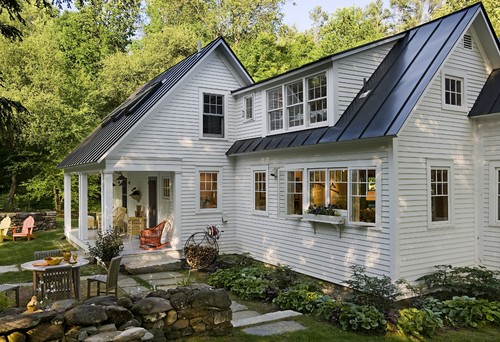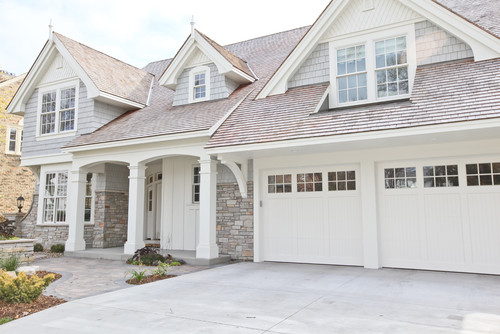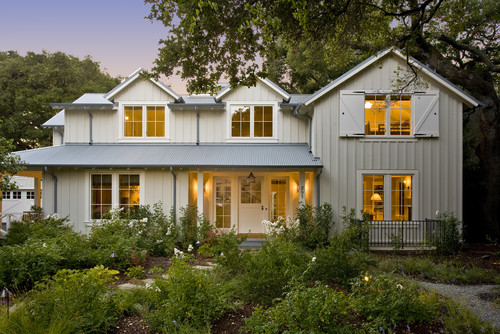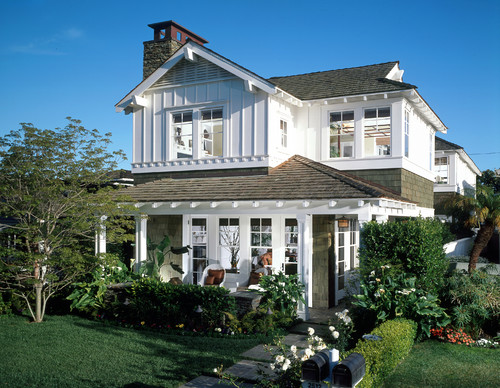Sun, Dec 2, 2018
Article may contain affiliate links. As an Amazon Associate I earn from qualifying purchases.
 Exterior Paint Colors Are More Important Than Ever / Photo via Houzz
Exterior Paint Colors Are More Important Than Ever / Photo via Houzz
Just because there are thousands of house colors and paint combinations to choose from doesn’t mean they’re all available to you. In fact, most should be forbidden to any well-meaning homeowner.
Our suburban landscape is littered with regrettable house colors and poor design choices.
So, before we get started I have one small request, actually it’s a demand.
**I’m asking you to throw away any and all paint ideas you currently have. **
Do it now and don’t look back. You’ll thank me later.
In our current real estate market every design decision matters. Even the most subtle changes to your house colors can improve the perceived value of your home, making it stand out from your neighbors.
However, choosing the wrong paint colors could cost you thousands of dollars in lost equity down the road.
How to Pick the Best Exterior House Colors
 Light Colors Will Always Make Your House Look Larger / Photo via Houzz
Light Colors Will Always Make Your House Look Larger / Photo via Houzz
How can choosing paint colors make a home look bigger and improve curb appeal?
The answer is simple.
In our DIY era more homeowners are taking critical design decisions into their own hands and dropping the ball. This is an opportunity to use your neighbors mistakes to your advantage.
Making smart, well-educated house color decisions will help your home stand out from the rest, while still giving you the opportunity to do it yourself and have fun along the way.
It’s no secret that today curb appeal is at a premium.
With an overwhelming number of homes on the market and many of them available at extremely affordable prices, anything you can do to maintain or improve home value is critical.
Even if you don’t plan to sell within the next year or two, planning ahead will save you countless headaches down the road and potentially put thousands of dollars.
For some families the house painting process seems to be a very personal decision. With thousands of paint colors to choose from, it appears that anything is possible.
But it’s not!
Let’s be honest, there are only a few colors that are suited for your home.
My goal is to give you the best return on your home painting investment.
Creating an outcome that you will look back on 10 years down the road and be thankful you didn’t choose that awful aquamarine color. This will be a decision that makes your neighbors wonder if you hired a pro, and will continue to turn heads for years to come.
Step 1: Evaluate Surrounding Elements
 Evaluate Surrounding Elements and Features for Contrast / Photo via Houzz[/caption]
Evaluate Surrounding Elements and Features for Contrast / Photo via Houzz[/caption]
When choosing the perfect house color it’s important to acknowledge and respect the surrounding environment of your home. Stand outside your house and take a step back to see the larger picture.
How does your home fit into the neighborhood? How is your home influenced by the landscape and other surrounding elements? First take a wide-angle approach on your color selection before focusing on any specific colors.
Homes in a suburban neighborhood, often built close to one another, will need to carefully evaluate their surrounding house colors. If homes around yours are painted in dark or subdued colors, a light or neutral palette will make your house stand out from the rest. Lighter colors also have a more clean and timeless appearance.
This same strategy must be applied to homes on property or those with elaborate landscaping. How can you use color to pull the house out from its surroundings and make it stand out? Typically, white or off-white will provide contrast to the other elements making it look larger than it really is.
Step 2: Determine Base, Trim and Accent Colors
 Use Base, Trim and Accent Colors to Bring All Elements Together Photo via Houzz
Use Base, Trim and Accent Colors to Bring All Elements Together Photo via Houzz
The next step in choosing the best house color is to pay close attention to trim and accent colors. They can make or break the perfect paint scheme. In fact, I believe they are the secret ingredient in the house painting process.
After deciding on a base color the rest of your design decisions will be based on this first choice. The trim must be neutral and complimentary of the base. Although it’s common for naive homeowners to choose a contrasting trim color, this is a decision you must avoid.
A contrasting color will emphasize design elements that are better left unnoticed. Garage doors, poorly placed windows and unattractive rooflines are usually outfitted in trim. A neutral color will help expand the surface area of the home, allowing the base color extend to the edges of the house envelope.
Complementary colors are to be used for accents as well. For example, a well selected accent color for the shutters can help accentuate the architectural features of a home. The accent colors will help draw attention to the well designed features. These are the areas that will be noticed and appreciated by your neighbors.
Step 3: Pick the Correct Sheen
After selecting the appropriate main body, accent and trim colors the next step is to decide on the correct sheen. Sheen is the term used to describe the degree of light reflection paint has. A flat paint will reflect almost no light, whereas a high-gloss paint will have high-reflectivity giving it a shiny appearance.
The decision on which sheen to choose will also be influenced by the condition of the existing surface as well as the desired durability. For example, flat paints are best for use on large areas. Due to the nature of flat paints they are perfect for hiding any surface imperfections that occur on exterior wood or metal surfaces.
Semi-gloss and gloss paints are preferred for accent and trim applications. The higher sheen makes window frames and doors easier to clean. Glossy paints also tend to give trim and accents a professional, finished look.
Conclusion
With all of these elements in mind, the key to choosing the best paint colors is simply not to go overboard.
If you take anything away from this, I hope that you choose a light base color in addition to neutral trim and accent colors. This is the key to using the right colors to make your house look bigger and create lasting home value.
READ NEXT
